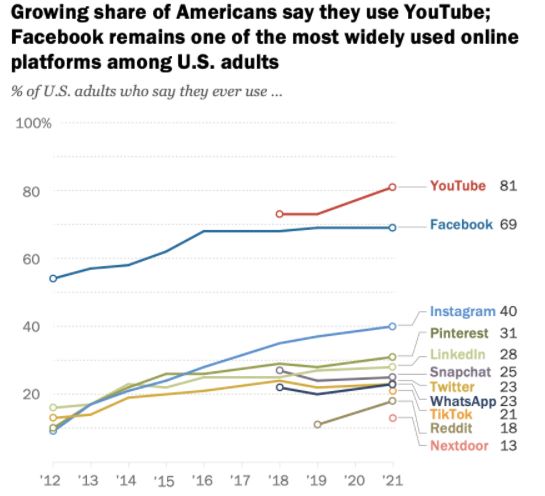I’ve been waiting anxiously for this day and it finally came yesterday—Pew Research announced its results for its annual social media usage survey. While I look forward to these results every year, I was especially excited to see if there were big differences this year, given the way the pandemic has changed the way we live our lives. But… not much has changed on a macro level.
Let’s start with Facebook. While Facebook has undoubtedly had its share of bad press, it remains the most used social media platform by US adults aside from YouTube. Instagram comes in next, with about 30% fewer users than Facebook, but about 10-15% more users than any other platform.
In my course and coaching program, I encourage 3-6 Facebook and Instagram posts a week and I go against the grain and say that aside from a few linking and hashtag adjustments, those posts can be identical. I know, I know… not everyone agrees on this, but I happen to think it’s the most time sensitive way to get on the two most widely used social media platforms… and the results speak for themselves.
I also teach a weekly process in that program (summarized here on the blog) that integrates a weekly Facebook Live video with YouTube and email marketing. This is a process I’ve used with clients for several years because of the power of video, YouTube, Facebook, and Email marketing combined. If you want to succeed at digital marketing… these places are where the conversions happen. Remember, trends come and go, but classics remain. Love it or hate it, these are the classics.
Before I go, I’d like to point out two additional important takeaways from this survey:
- YouTube. YouTube is considered a social media platform, but if it were a search engine, it would be bigger than all search engines except for Google. Why is this important? Because I advise that you use YouTube like a search engine.
Only 9% of US businesses have a YouTube account, but as you can see on the graph, 81% of people (aka potential customers) use YouTube. This means as a business, there is a lot of potential for you to benefit from (and stand out on) YouTube… but only if you think about it like a search engine. Here’s what I mean…
I am not at all surprised to see a spike in YouTube usage this past year. We all had to do things at home that we would normally outsource. For example, my husband Googled a video about how to fix a dishwasher when ours broke last May because we weren’t sure we wanted the repair team coming into our house. The company that made the video was smart and put a location tag on their video, so he unknowingly had clicked on a how-to video from a local company. When he couldn’t get the dishwasher fixed, that company benefitted from our new dishwasher purchase because he realized as he watched the video, that he was watching someone from a store about 20 minutes away. That company was sure smart to think of themselves as search engine.
Moral of the story: Be among the 9% and upload your videos to YouTube as a source of passive SEO. Use tags wisely to make it work in your favor.
2. Reddit, TikTok and all the rest. There is a lot of buzz surrounding smaller and newer social media platforms. Younger people want distance from their parents and grandparents and the Zuckerberg machine, so they take to TikTok to express themselves. The buzz has gotten so loud that you may have found yourself running Googling a TikTok tutorial on YouTube (see the point I just made there?) to figure out how to use it. Just remember the difference between a user and a buyer. If your main audience are people between the ages of 18-24, then by all means take the time to toe wet with some of these rising apps. However, don’t abandon the ones we know work well, especially since the buyer might actually be the parent who is still enjoying Facebook ads every single day, or the 18-24 year old who still lurks on Facebook but will only admit it anonymously to Pew Research.











